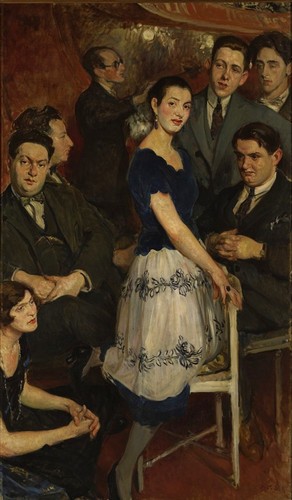
ReviewsStephen Coxe and Friends Once again Christ and St. Luke's Sacred Music in a Sacred Space series and Kevin Kwan, director of music and organist, hosted Stephen Coxe and Friends. This ninth evening of Mr. Coxe's chamber music series featured eight of the area's finest singers and instrumentalists anchored by Stephen Coxe as solo pianist, accompanist, composer and impresario par excellence. The beautiful program booklet offered a color reproduction of Stephano di Giovanni (1392-1451) The Journey of the Magi (1435) on the cover with texts, biographies and information on each piece performed. I chose to regard each selection as a gift to honor the live audience in this sacred season. Five selections from Choral Preludes (1998) by Coxe (the first three were heard here played by Kwan on December 8, 2015) were splendidly played by organist Dr. Kwan. Each piece is based on a well known church melody similar to those used by J.S. Bach in his contrapuntal compositions while Coxe used a modal harmonic language of the late twentieth century. I found the first (Now come savior of the nations) easy paced leading to introspection, thinking how happy I feel hearing live music with other listeners. The second (In Sweet Rejoicing) is set in canon in all voices with double pedal. It opens delicately, lightly. Of the third (A boy is born in Bethlehem), Coxe wrote “ My setting treats the melody as an evocation of the annunciation to the shepherds who gradually become overwhelmed by the immensity and strangeness of the event." In the fourth(What God does is well done), the concert organ rouses to a big sound but never overwhelms. The trumpet stop is accompanied by an echo canon in the top voice of the manuals. The melody of the fifth (Praise the Lord, Jerusalem) is one used by Bach. Here the top voice is the melody with lively counterpoint underneath. I heard it as a Bach-like theme that concluded the set. Steve Coxe then played Pavane pur une infante défunte (1899) by Maurice Ravel (1875-1937). The experience was like opening a gift—familiar music beautifully played on a grand piano in an open acoustic space. Deep within the piece the urgency builds, resolves and then flows on enticingly. The last statement of the opening melody is much fuller than the previous two and here Ravel makes a dramatic move: the pianissimo in a few concluding bars moves into a grand fortissimo.
The next present under the tree was a real surprise. Elizabeth Vonderheide, violin with Coxe, piano performed music new to us: Germaine Tailleferre (1892-1983) Sonatine from 1973. The scintillating playing was wonderful. Exploring Tailleferre's life makes me wonder why we had not heard her music before. She defied her family to study at the Paris Conservatory where she and her fellow students, all influenced by Eric Satie, became known as “Les Six” (Georges Auric (1899–1983), Louis Durey (1888–1979), Arthur Honegger (1892–1955), Darius Milhaud (1892–1974), Francis Poulenc (1899–1963), and Germaine Tailleferre (1892–1983). She studied with Maurice Ravel and often visited him. During WWII she lived in the United States. Her musical style is fresh and spontaneous, demonstrated so well by Ms. Vonderheide—expertly crafted, deeply emotional, and with variety. Her ballet scores were danced in Paris and her thirty-five film scores were written between 1926 and 1966. Please bring us more of her music! It is no surprise that the notes say “slow, gentle, distant with a sad feeling” for Debussy's Et la lune descend sur le temple qui fut (And the moon descends on the temple that was). It seems faintly Mid-Eastern, as in The Arabian Nights. Taking off her mask, Kathryn Kelly sang Coxe's three Everwine Songs (2009). It was so nice to see beautiful faces again as Amanda Gates accompanied on viola. How It Is captures a nostalgic moment of coming home. It Was Autumn offers a topsy-turvy world illuminated by moonlight and a natural soundtrack of crickets. In the third song, Night, the viola speaks and the singer tells of being alone and summoning all she loves to come to eat with her. After a brief intermission we heard two interrelated pieces. Magi videntes stellam (The Magi seeing the star) followed by Benjamin Britten's Canticle IV: The Journey of the Magi, Op. 86. The text is a monologue by T.S. Eliot that comes to life in three voices: John Irving, countertenor; Scott Crissman, tenor; Michael Kotrady, bass, with Coxe at the piano. The voices were wonderful and sounded marvelous in that space.Carefully following the provided text transported me to a mystical space, leaving me feeling expectant and alert. The voices, solo, in duet and trio created the drama of the arrival of the Magi captured by the narrator as an ancient tale sung in close harmony. The text leaves us with a question: was this birth really the death of the old dispensation, or the birth of a new order? The Magi, back in their respective homes but not at ease there, sing “...this birth was hard and bitter agony for us, like Death, our death.” The last piece on the program was Debussy Sonata for Violin and Piano (1916-1917). The third in a projected series of six chamber sonatas was Debussy's last work before he died in 1918. Here he fuses elements of mainstream concert tradition with a wholehearted affinity for gypsy violin playing. There was fire in Olivia Cottrell's approach, speed and intensity shared with the pianist, interspersed with languorous phrases filled with nostalgia. especially In the third movement a flowing, liquid opening builds in intensity, quickly speeding toward a slow-paced, placid beauty. This becomes a rippling violin with stately piano. All of this order unravels quickly to end in a staunch fortissimo in the home key of G major. A stunningly exciting end to a wonderful evening of music!
|
